Explore All
BROWSE BY CATEGORY
Interior
Exterior
Home Essentials
Homeowner Tools
Blogs & Guides
Find a Pro
Book Your Appointment Now
Home Essentials
About Renovize Home
Explore All
BROWSE BY CATEGORY
Interior
Exterior
Home Essentials
Homeowner Tools
Blogs & Guides
Find a Pro
Book Your Appointment Now
Home Essentials
About Renovize Home
Last Updated on October 16, 2025
Replacing your roof shingles is a big job, but it protects your home. Shingles wear out over time due to weather changes, the age of the roof, and other factors. If your shingles are showing signs of wear, replacing them can prevent leaks, water damage, and expensive repairs later. In this, we’ll go through everything you need to know about replacing your roof shingles, from signs to look for, costs, and even what materials to choose.
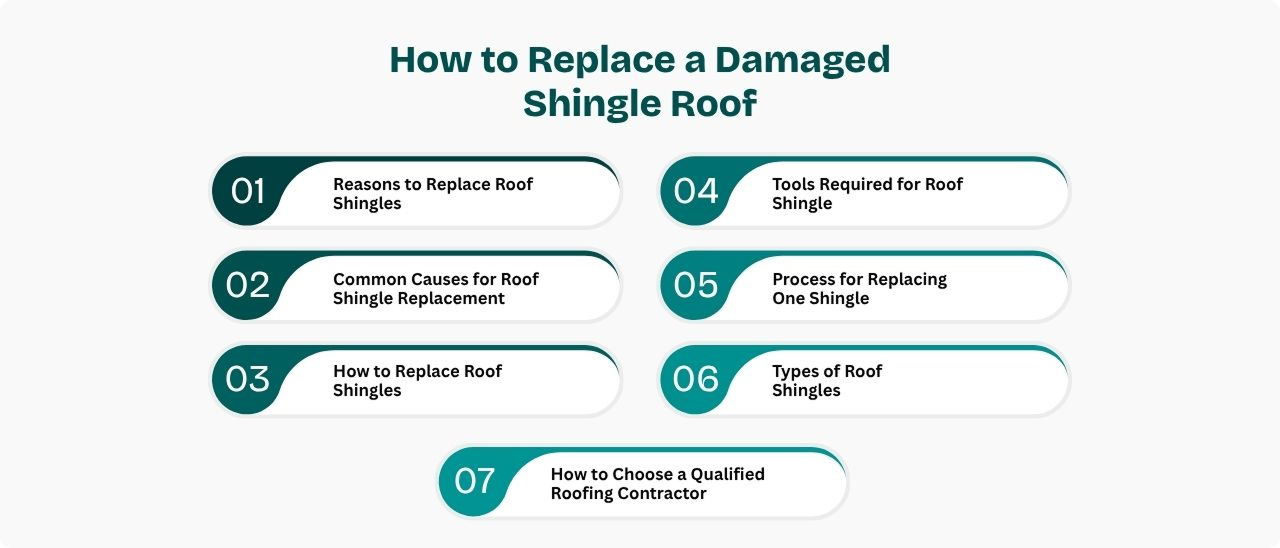
Table of Contents
Understanding Shingle Roof Replacement
Reasons to Replace Roof Shingles
Common Causes for Roof Shingle Replacement
How to Replace Roof Shingles
Replace a Single Roof Shingle
Cost to Replace Roof Shingles
Types of Roof Shingles
When to Replace Roof Shingles
How Often Should You Replace Roof Shingles?
Replacing Roof Shingles with Other Materials
Shingle Roof Replacement Contractors
Ending Views:
When you think about replacing shingles, it’s important to understand what the process involves. A shingle roof replacement is the process of removing old, worn-out shingles and replacing them with new ones to restore your roof's functionality and appearance. This type of roof replacement ensures that your home remains well-protected against the elements.
Roof shingles are like a protective shield for your home. They sit on top of your roof and help stop rain, snow, and heat from getting inside your house. Over time, though, roof shingles can wear out. This can happen because of the weather, like strong sun or heavy rain, or simply because they’re getting old.
As shingles begin to break down or get damaged, they can stop doing their job properly. When that happens, water can leak into your home and cause damage to your walls, ceilings, and even your foundation. If the shingles are cracked or missing, it also makes it easier for heat to escape, which can cause your energy bills to rise.
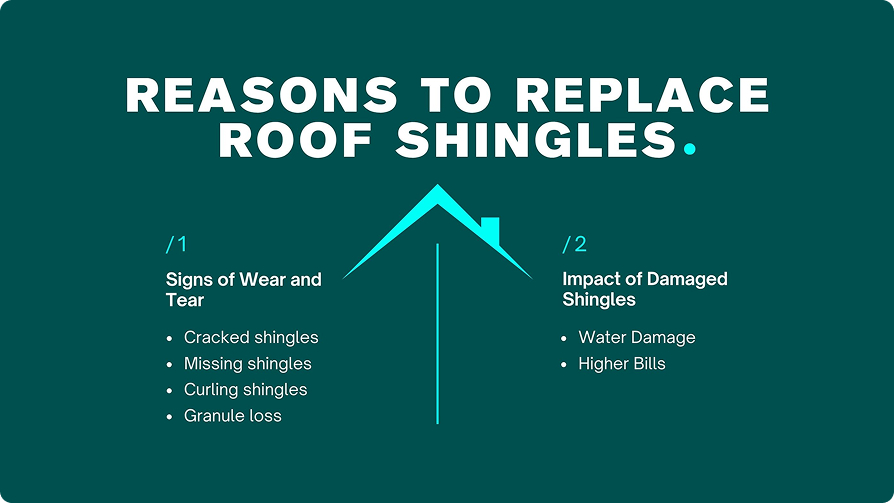
As your roof shingles age, they can show signs of wear and tear. Even small problems can signal that it’s time to replace them before they cause serious damage to your home. Look for these common signs that indicate your shingles are reaching the end of their lifespan:
Damaged shingles can't do their job of protecting your roof from rain, snow, and wind. When shingles are cracked, missing, or worn down, water can easily get under them. If this happens, it can cause leaks in your roof, and the water may start to get into your attic and ceilings. This can lead to mold growing in your home, which is unhealthy and expensive to fix. Replacing damaged shingles is important because it helps keep your roof strong and watertight, just like it was when it was first installed. This ensures your home stays dry, safe, and protected from the weather for many more years.
Roof shingles don’t last forever. Over time, they face wear and tear from the weather, age, and even unexpected events. Understanding the causes behind shingle damage can help you know when it’s time to replace them before bigger problems occur. Here are the most common reasons why your roof might need a shingle replacement:
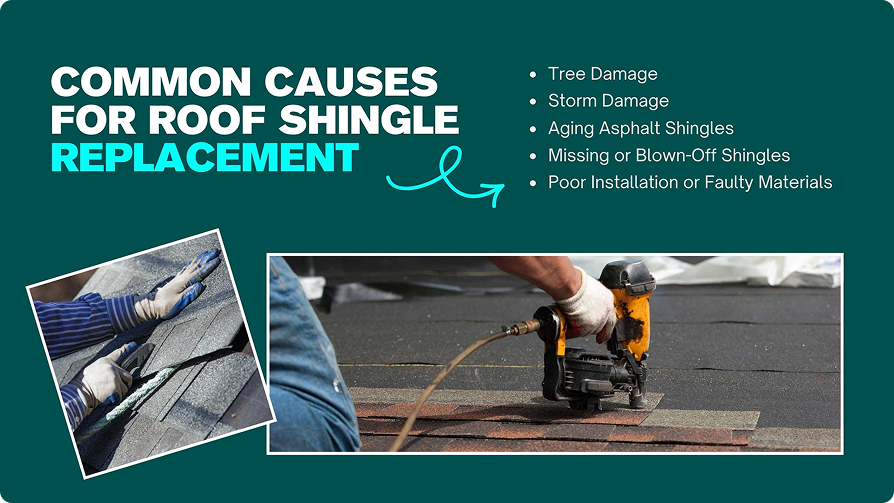
Heavy storms, high winds, and hail can cause serious damage to your shingles. These weather events may crack, tear, or even blow shingles off your roof completely. Storm damage is one of the leading causes of roof replacements, especially after extreme weather conditions like hurricanes or tornadoes. If your shingles show visible damage after a storm, it’s best to have them inspected and replaced before leaks or further damage occur.
Asphalt shingles typically last between 15 to 30 years, but as they age, they start to lose their effectiveness. Over time, the shingles can become brittle, leading to cracks and granule loss. Granules are tiny pieces that protect your shingles from the sun's UV rays. When they wear away, the shingles are more vulnerable to further damage. Aging shingles won’t protect your home as well, so if your roof is older, it’s time to start thinking about a replacement.
Strong winds can blow shingles off your roof, leaving exposed areas that are no longer protected. If you notice missing shingles, it’s important to replace them as soon as possible. Missing shingles create gaps in your roof's protection, which can lead to water leaks and damage. The longer these gaps go unaddressed, the more likely it is that water will seep into your attic and cause mold or structural issues.
Sometimes, roof shingles fail not because of age or weather, but because they were poorly installed. If shingles were improperly aligned, fastened, or sealed, they may not provide the protection they were designed for. Over time, improper installation can cause shingles to come loose, crack, or wear out more quickly than expected. Additionally, if low-quality materials were used for your roof, they may deteriorate faster and need to be replaced sooner than higher-quality shingles.
If you have trees near your home, tree branches can pose a significant threat to your roof. During storms, or even just high winds, branches can scrape or puncture shingles, leading to cracks and holes. This can also happen over time if branches rub against your roof constantly. It’s essential to trim any overhanging branches regularly to avoid this type of damage, and if tree damage has occurred, replacing the affected shingles is necessary.
Our professional contractors are just a click away.
Replacing roof shingles is a crucial job to ensure your home remains safe from the elements. This is not a quick DIY fix, it requires the right tools, careful planning, and proper safety precautions. Let’s walk through the basic steps to make sure you get the job done right.
Before you begin replacing any shingles, it's essential to inspect the roof thoroughly. Start by looking for any visible signs of damage, such as cracked or missing shingles. If you notice areas that are soft or feel spongy, these could be weak spots that need attention.
Once you’ve inspected the roof and identified the damaged shingles, the next step is removing the old ones. Start by using roofing tools like a roofing shovel or specialized pry bar to gently lift and remove the shingles. Be careful during this process to avoid damaging the roof deck, which is the underlying material that supports the shingles. If you damage the deck, it could cause further problems down the line. The purpose is to clear away all the damaged shingles and expose the underlying layers so that the new shingles can be installed properly.
After the old shingles are removed, it’s time to install the new ones. Follow the manufacturer’s instructions for each type of shingle, as they may have specific guidelines for placement and alignment. When installing the new shingles, make sure that each one overlaps the one below it. This ensures that water flows smoothly off the roof without getting trapped under the shingles.
Proper nailing is also important, make sure each shingle is securely fastened with nails placed in the right spots. If the nails are placed incorrectly, it could lead to leaks or the shingles lifting over time. Carefully follow all instructions to ensure the new shingles are installed correctly and will provide long-lasting protection for your home.
As you replace your shingles, don’t overlook the importance of ventilation and flashing. Proper ventilation allows air to flow freely through your attic, which helps prevent moisture buildup that could lead to mold or rot. It’s important to check that your roof has enough ventilation and that it’s not blocked by debris or improperly installed shingles.
At the same time, flashing the material that seals areas where shingles meet other structures, like chimneys or vents, is essential for preventing water from seeping in at vulnerable points. Make sure the flashing is properly sealed and installed during the shingle replacement to ensure a watertight seal that will protect your roof from leaks in the future.
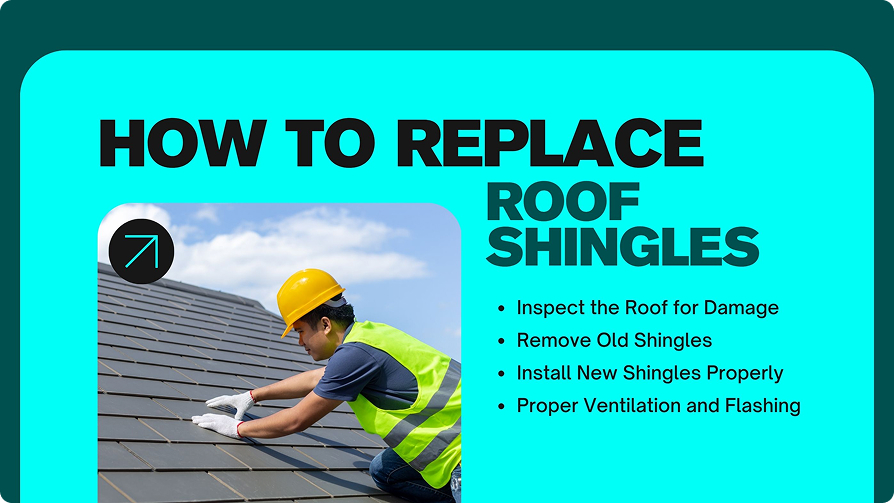
Replacing just a single damaged shingle can be a quick and easy solution without needing to replace the entire roof. This is great if you only have a few damaged shingles, like from a storm or strong winds, and you want to save money by fixing the issue without doing a full roof replacement. Let’s walk through the tools you need and the steps involved in replacing a single shingle.
Before you begin replacing a single shingle, make sure you have the right tools and materials to do the job correctly and safely. Here’s what you’ll need:
These are the basic tools you’ll need to safely remove the damaged shingle and install a new one. Having everything ready before you start ensures a smooth, quick process.
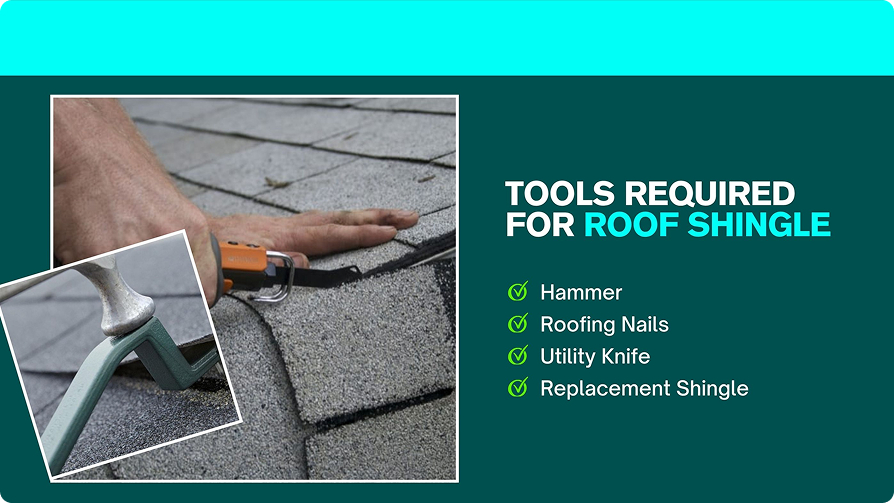
Replacing a single shingle isn’t too difficult, but it requires careful attention to detail to make sure the new shingle fits properly and doesn’t cause future leaks. Here’s how you do it:
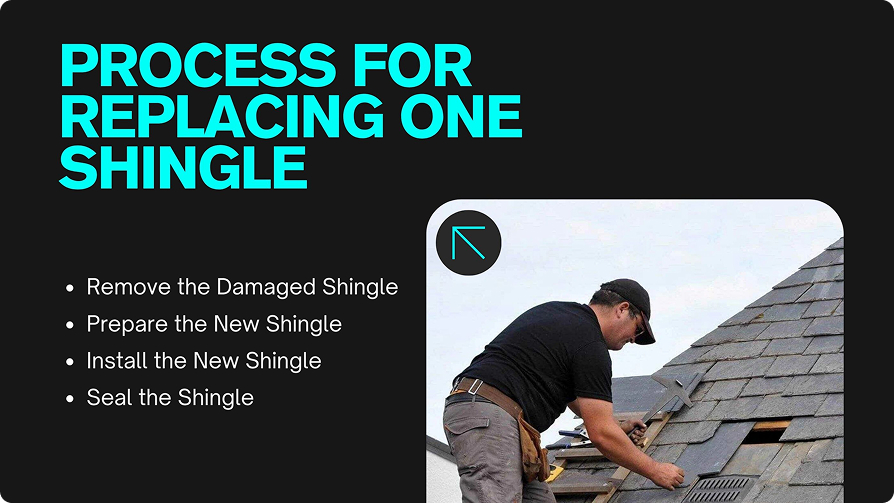
Replacing your roof shingles isn’t a one-size-fits-all cost. The price depends on several factors: the type of shingles, the size of your roof, labor costs, and material quality. Here’s a visual guide to help break down how pricing works, with details to support each component of the cost.
Cost Factors to Consider
| Feature | Details | Average Cost Range |
|---|---|---|
| Average Cost to Replace Asphalt Shingles | Depends on roof size, materials, and labor. | $3,000 - $10,000 |
| Cost Breakdown by Roof Size | Roof size is measured in "squares" (100 sq ft per square). | Small Home: 15-20 squares (100 sq ft each), Larger Home: 30+ squares |
| Cost of Replacing a Single Shingle vs. Full Roof | Single shingle replacement is minimal cost. Full roof replacement costs more. | Single Shingle: ~$100, Full Roof: $3,000 - $10,000 |
| Contractor Rates | Rates depend on location and job complexity. Contractors charge hourly or flat rates. | $50 - $100 per hour |
| Cost per Square | Roofing is usually priced per square (100 sq ft). | $100 - $400 per sq, $100 - $400 per squareuare |
Below is a bar graph representing the cost range per square (100 square feet). It helps show how the cost can vary based on materials and labor.
Here’s the bar graph representing the cost per square for roof replacement. It visually compares the costs for:
This graph makes it easy to see how material choice and labor can impact the overall price.
Roof size is another major factor in pricing. A roof square is 100 square feet of roofing. Here's how the size of your roof affects the cost:
Pricing per square can vary depending on a few things:
For instance, if you have a 1,000 sq ft roof:
Labor Costs: Don’t forget that labor also affects the total. If you are installing complex shingles (like slate), the labor rate may be higher, so your total cost can increase significantly.
To calculate the total square footage of your roof, follow these steps:
For example, if your roof is 40 feet long and 30 feet wide, the total square footage is: 40 x 30 = 1,200 sq ft 1,200 ÷ 100 = 12 squares (this means you need 12 squares of shingles).
When you’re looking at roof shingles, there are several types to choose from. Each type has some benefits and drawbacks. Let’s dive into the most common ones:
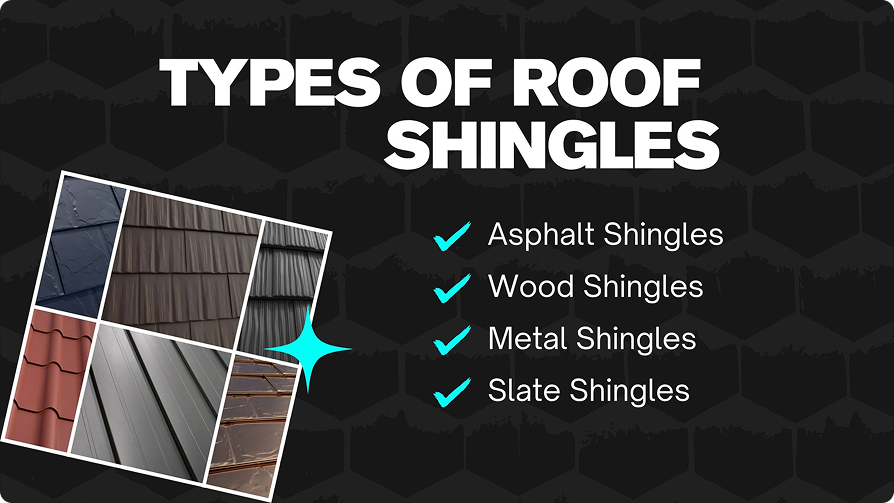
Asphalt shingles are the most common and affordable roofing material. They're designed to be both durable and easy to install. These shingles are widely used because they come in a range of colors, styles, and price points.
Wood shingles offer a natural look that suits homes with a rustic or traditional aesthetic. Made from wood such as cedar, pine, or redwood, these shingles are durable but require more maintenance compared to other types.
Metal shingles are lightweight, durable, and energy-efficient. They are often used in modern homes or eco-friendly builds due to their long lifespan and resistance to extreme weather conditions.
Slate shingles are a premium roofing material made from natural stone. They are known for their elegance, durability, and long-lasting qualities, but they require professional installation due to their weight.
Knowing when to replace your shingles is crucial to keeping your home safe from damage. If you ignore worn-out shingles, you could be putting your home at risk for leaks, water damage, and costly repairs. The key is to watch for signs that your shingles are no longer doing their job properly, so you can replace them before the damage becomes worse.
Shingles are meant to protect your roof from rain, wind, and sun, but when they’re damaged, they can’t do that anymore. If you see shingles that are curled at the edges, cracked, or completely missing, it’s a sign that your roof is no longer fully protecting your home. These damaged shingles allow water to get under them, which can lead to leaks in your roof and walls. It’s important to replace them as soon as you notice these issues to prevent water damage from spreading.
Shingles are coated with tiny granules, which help protect them from the sun’s harmful UV rays. Over time, these granules wear off, especially if the shingles are old or have been exposed to harsh weather. If you notice granules collecting in your gutters or on your driveway, this is a clear sign that your shingles are wearing down. Granule loss means your shingles are becoming more vulnerable to the elements and may need to be replaced to prevent further damage.
One of the most obvious signs that your shingles need replacement is water leaks or stains in your attic or ceiling. If you notice these signs, water is likely getting under your shingles and causing damage to your home’s structure. Leaks can lead to mold, wood rot, and even foundation problems. If you see water stains on your ceiling or walls, it’s time to replace your shingles and fix the leak before it gets worse.
Roof shingles don't last forever, but the length of time they last depends on several factors, such as the material, weather, and maintenance. Most roof shingles have a lifespan of around 15-30 years, but knowing when it's time to replace them can save you from unexpected leaks and damage. Regular inspections help you spot issues early, so you can replace your shingles before problems arise.
Asphalt shingles are one of the most common roofing materials. They typically last 15–30 years, depending on the quality of the shingles and how well they’ve been maintained. Asphalt shingles can start to degrade faster if they’re constantly exposed to harsh weather conditions like extreme heat, heavy snow, or storms. Over time, they become brittle, lose their granules, and may begin to crack, signaling the need for replacement.
Several factors affect how long your shingles will last and when they need to be replaced. Some of the most important include:
If your shingles are showing signs of early wear, like curling, cracking, or losing granules or if you notice leaks and water stains, it’s a good idea to replace them sooner rather than later. Replacing shingles early can help prevent more expensive repairs down the road, like mold or rotting wood. If your roof is 10 years or older, it’s also a good idea to have it inspected, even if you haven’t noticed any visible problems.
If your roof needs replacement, you don’t have to stick with traditional asphalt shingles. You can consider upgrading to metal roofs, solar panels, or other materials that offer better durability and energy efficiency. These alternatives may cost more upfront but can provide long-term benefits.
Replacing asphalt shingles with a metal roof is a great option if you want something more durable and energy-efficient. Metal roofs are designed to last longer than shingles, often up to 50 years or more. They’re also great for areas with extreme weather conditions, as they can withstand strong winds, heavy snow, and hail. While metal roofs are more expensive than shingles, they can help you save money on energy bills and require less maintenance in the long run.
Here are slime pros & cons of metal roofing:
Pros and Cons of Metal Roofs
| Pros: | Cons: |
|---|---|
| Long lifespan (50+ years) | Higher upfront cost |
| Energy-efficient, keeps your home cooler in the summer | It can be noisy when there is heavy rain or hail |
| Fire-resistant and weather-resistant | A complex installation may require professional help |
Cost of Replacing Shingles with Metal: Replacing your shingles with metal typically costs around $5 to $12 per square foot, depending on the type of metal you choose and your roof's complexity. This can be more expensive upfront compared to asphalt shingles, but it pays off in the long run through energy savings and long-term durability.
Another upgrade is replacing your shingles with solar panels. This option is perfect for homeowners looking to increase energy efficiency and reduce utility bills. Solar panels can be installed directly over existing shingles or replace them completely. This investment can pay off in the long run through energy savings and tax incentives.
There are many benefits of solar panels, some are given below:
Solar panel installation is a significant investment, with costs ranging from $10,000 to $30,000, depending on the size of the system and the complexity of the installation. However, solar panels offer long-term energy savings and are eligible for tax rebates and incentives, which can help offset the costs.
Replacing roof shingles is a big task, and it’s often best left to the professionals. Hiring a qualified roof replacement contractor ensures that the job is done safely, efficiently, and according to local building codes.
Roofing contractors have the right tools, experience, and skills to replace your roof. They know how to handle complex roof designs and ensure that the shingles are installed correctly to prevent future issues. Professional contractors also offer warranties, which can give you peace of mind knowing that if anything goes wrong, they will take care of it.
When hiring a roofing contractor, it’s essential to ensure they are qualified and reliable. A well-chosen contractor will not only complete the job correctly but also provide peace of mind throughout the process. Here are key factors to keep in mind when selecting the right professional for your roof replacement:
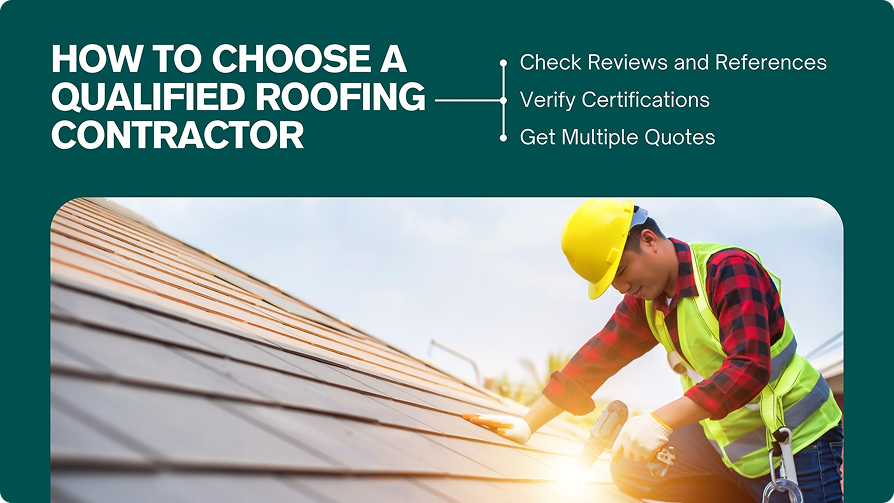
Replacing your roof shingles is important to protect your home from damage caused by weather and aging. Whether replacing a few shingles or the entire roof, it's important to act when signs of wear appear. Consider different materials based on your budget, climate, and long-term needs. Always consult with a qualified contractor to ensure proper installation and avoid costly repairs in the future.
Architectural or laminated shingles are ideal for high-wind areas as they are heavier and more durable. Additionally, installing shingles with better wind resistance ratings and using proper installation techniques can reduce the risk of damage during storms
Lighter-colored shingles reflect more sunlight, which can help keep your home cooler, reducing the need for air conditioning. Darker-colored shingles absorb heat, which might increase energy costs in warmer climates, but they can help with heating in colder months.
Installing new shingles over old ones is possible in some cases, but it is not recommended. Layering shingles can lead to problems with proper ventilation, and it may not meet local building codes. Removing the old shingles ensures a better seal and longer-lasting roof.
Replacing traditional shingles with a solar roof can be a smart long-term investment, especially if you live in a sunny region. While the initial cost is higher, solar roofs can reduce your energy bills and increase your home's value. It’s essential to calculate your return on investment based on your energy savings.
Depending on the extent of the damage, a leaking roof might only require patching the affected area. However, if the shingles are severely damaged, it's advisable to replace them to prevent further issues and maintain the integrity of the roof.
Join our mailing list for exclusive updates, expert tips, and special offers tailored to your needs. Be the first to know about the latest in home services.


Renovize Home is a platform that supports homeowners from planning to renovation. Whether it’s Renovize AI for guidance or a one-on-one call with Pro Finder, we understand your project and match you with local contractors tailored to your needs.
Who We Are
About Renovize HomeGet in TouchHomeownwer Support:
Coming Soon!
General Inquiries:
support@renovizehome.com
Head Office:
24 Greenway Plaza, STE 1800M, Houston, TX 77046.